The hot topic at water coolers these days is: "Who's retiring now? And who's taking their place?"
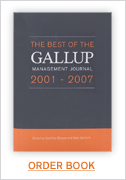 |
That's not a surprise. In 2006, the oldest of the baby boomers will turn 60, which will mean big changes in the workplace. According to the U.S. Department of Labor, baby boomers will reach the traditional retirement age of 65 between 2011 and 2029, and "their retirements will dramatically affect the workforce of the future."
Even though this a reality, too many executive teams are neglecting to have thoughtful discussions about their leadership pipelines. The question they should be asking is: Who is capable of guiding our organization into the future?
Forward-thinking organizations know that they need leaders and a leadership succession plan that deliver results. Most succession plans are devised with good intentions, but few have the right criteria and measurements in place to deliver those results.
As you think about your organization's succession plan, keep these points in mind:
- What experience and skill factors are essential to your future?
- How will you assess the talents of potential leaders?
- How can you best assess the performance of emerging leaders?
Skills and experience. A candidate's skills, knowledge, and experience must be considered and weighted appropriately. For example, to lead the financial function in an international company, a candidate's immersion in and expertise about exchange rates -- and his or her appreciation of cultural nuances -- could be very important.
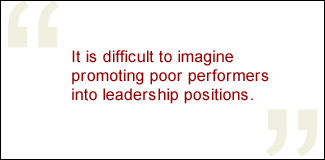 |
Talent. An effective leadership succession plan starts with fundamentals, beginning with a talent review. Who has leadership potential in your organization? And how do you identify those people? Identifying leadership potential requires a way to predict how effectively a candidate will perform in a leadership role. The accuracy of that prediction depends on a variety of factors and sources of evidence, not just whether an employee has demonstrated leadership capability in his or her present role.
Current performance. What are the key performance outcomes for the candidate's current role? How well is he or she meeting them? Reviewing current performance provides insights into his or her potential performance in a leadership role. It is difficult to imagine promoting poor performers into leadership positions.
Integrating measures of a candidate's current performance with an accurate prediction of leadership potential is crucial to an effective talent identification process. The Succession Planning Grid below offers a useful way for organizations to consider a candidate's current performance and leadership potential. In the following section, we'll discuss how to evaluate current performance, then explore how to assess a candidate's potential for leadership success.
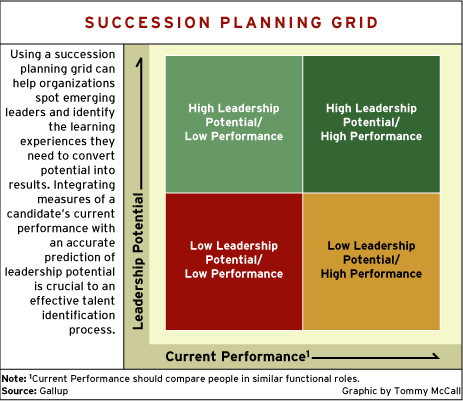 |
Evaluating current performance
The first step in the talent identification process is determining what metrics to use to plot current performance. What are the key performance outcomes for the role? In other words, what actions or responsibilities are non-negotiables, and which ones are merely "nice to have"?
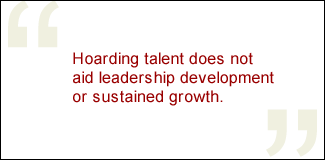 |
Most performance measurement systems lack simplicity and clarity or are too heavily weighted toward subjective factors. Performance measurement typically falls into one of these categories:
-
Poor metrics. Some organizations use metrics that measure the wrong things or measure the right things ineffectively. Systems like these can actually encourage behaviors that run counter to the organization's goals or values.
-
Too many metrics. Other organizations use a numbers-happy potpourri of metrics. In systems like these, employees are often confused about expectations and have a hard time knowing what's important in their roles. They end up chasing after multiple metrics and are never quite sure whether they are doing the work that matters most. In this situation, few employees are able to perform their jobs well, let alone at excellence.
-
No metrics. Sometimes, there's no measurement at all.
Examples of skewed measurement systems abound. In one call center �鶹��ýAV studied, customer service reps (CSRs) weren't rated on how well they solved customers' problems; instead, they were rated on their ability to adhere to rules, such as taking breaks at the appropriate times. So, to get good evaluations, CSRs at this company take their breaks on time, but they often end up transferring customers to a different CSR, who then must start the problem-solving process all over again. Is it any wonder their customers are unhappy? In another company, sales executives were held accountable for 13 different metrics that measured everything from revenue and profit to counting cold calls. Another company had such strong employee relationships that the very idea of talking about performance and metrics was considered sacrilegious because it disrupted team harmony.
To plot performance consistently and accurately, organizations must:
-
Identify quantifiable measures that drive performance. This is not always easy. It requires organizations to avoid subjective assessments or irrelevant measures.
-
If multiple performance measures are used for a specific role, combine these measures into a single rating that reflects the relative significance each measure has on business growth.
-
Calibrate performance measures to a common and comparable scale so they can be accurately compared on the Succession Planning Grid. This may mean accounting for factors such as differences in location or market opportunity.
-
Hold line managers accountable for exporting talent internally. Great managers have a knack for identifying, growing, and moving talent within an organization. This helps expand the organization's performance capacity while preserving a workgroup's ability to achieve top performance. "Hoarding talent" does not aid leadership development or sustained growth.
Assessing leadership potential
Determining how to spot leadership potential can be challenging. When assessing possible leaders, executives often rely heavily on gut instinct and personal judgment, which have profound limitations. Part of the problem is that the existing crop of leaders generally has a pretty good picture of what it currently takes to be successful in their roles. It seems logical to them that they should be able to spot "rising stars" who are deserving of future advancement. But our experience suggests that they are not consistently good at it.
Well-meaning executives may go so far as to observe and evaluate leadership roles to determine the behavioral characteristics that are necessary for success in the role. Then a scoring process is used to assess these characteristics. There is tremendous value in clearly articulating leadership competence this way; it sends a strong message that the organization values leadership and knows what it takes to perform at excellence in a leadership role.
Unfortunately, this kind of assessment also has serious limitations. It's not easy for organizations to maintain objectivity and consistency about what is being assessed. They will have to be particularly vigilant to prevent unintended biases from influencing their assessments. This challenge is evidenced by the observation that many leadership teams lack diversity, whether it be in age, gender, race, or disability.
Using a validated, predictive assessment that is grounded in research is a far more effective way to assess a person's potential for success in a leadership role. Given that an organization's future rests on its ability to identify and develop leaders, using a validated predictive assessment is essential.
 |
The �鶹��ýAV Leadership Assessment is a good example of one such tool. Built on research conducted across industries and in numerous organizations throughout the world, this tool measures innate leadership talent and assesses aspiring leaders' talents in relationship to those they are seeking to succeed. It provides an objective measure that can help companies achieve diversity and avoid adverse hiring impact. It can also provide a benchmark of existing leadership strengths within a company or executive team, as well as assess potential leaders in light of those strengths.
How does a measure like this work in practice? Let's say, for example, that �鶹��ýAV is asked to measure a potential leader's fit with Company A's existing executive leadership team. First, �鶹��ýAV would question the leadership team members using the executive leadership assessment, measuring leadership ability in four crucial dimensions. (This assessment also provides a more complex analysis within each of these dimensions; this in-depth analysis has been omitted for the purposes of this article.) The four dimensions are:
-
Direction measures future focus and strategic capability. It assesses "big picture" aptitude and breadth of thinking.
-
Drive measures primary motivation and influence. It assesses what motivates leaders and how they enlist support and commitment.
-
Relationship measures a complex range of talents. It assesses the importance of close relationships, whether a person has natural networking abilities, whether he or she "reads" people well, and whether the person gets close in a coaching role.
-
Management evaluates management and operational ability. It assesses operational thinking, organized thinking, and natural capacity to thrive on complexity. It also assesses a person's goal orientation.
The result is a report detailing scores for Company A's chief executive officer, chief financial officer, chief operating officer, and five other executive team members, as shown in the graphic "Executive Team Leadership Report":
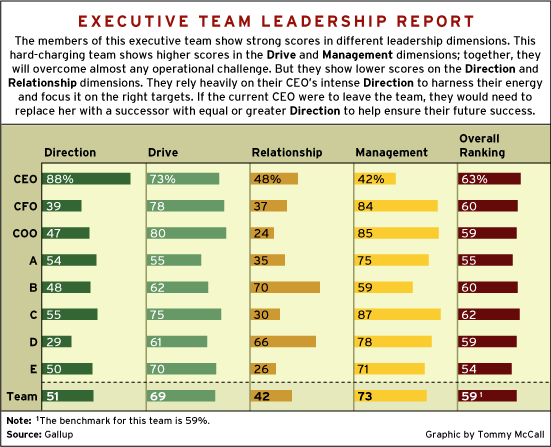 |
As the graphic shows, the individual team members show strong scores in different leadership dimensions. Generally speaking, though, this team is a highly driven, hard-charging group that is operationally astute. You can imagine them rolling up their sleeves and throwing themselves at every challenge they face -- and for the most part, they'll overcome their challenges.
Although it's likely that they work well together, most of the executives on this team show lower scores on the Relationship component; work is what brings them together. They also show lower scores on Direction. This suggests that the team will function well when work provides a clear direction, though they may not adapt easily to change. Thanks to their Drive and Management talents, this team may be expert at squeezing costs out of an operation, but they may be less adept at anticipating new market trends or exploiting new strategic opportunities.
If you look at the profile of the CEO, it's clear who is providing the executive team's Direction. This is a high-performing group, but it's less certain whether they will remain so once the CEO moves on. A smart team builder, this CEO has surrounded herself with people who complement her. However, does she fully appreciate her own contributions to the executive team or what it will take to match those contributions once she moves on?
Company A's profiles reveal two leadership challenges. First, this team needs to seek long-term successors who can sustain leadership capacity as current executives retire. And it's imperative that they seek a leader with a vision for the future when they're recruiting a new CEO.
Second, each new person who joins the executive leadership team needs to have as much leadership talent -- or more -- than the person he or she is replacing. For organizations to grow, top leadership needs to commit to hiring successors whose objectively assessed leadership talent strengthens, not weakens, the organization's leadership capacity.
Pulling the picture together
For every key leadership role in an organization, potential leaders should be evaluated against a succession matrix using objective measures of performance and leadership talent. This approach will provide a more complete picture of those who have the potential to be successful, as shown in the Sample Succession Planning Grid below.
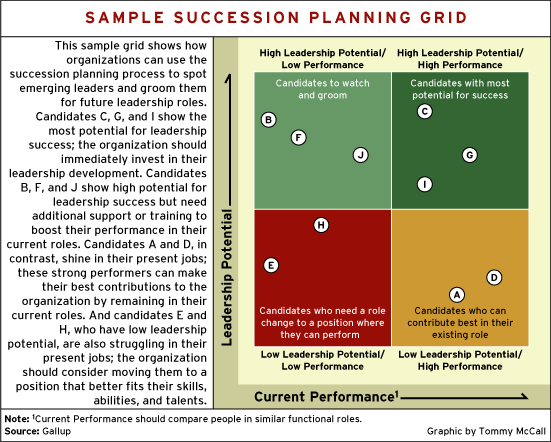 |
Organizations should invest the most time and energy developing the high-potential group. Using the Succession Planning Grid can also help organizations identify emerging leaders who may need additional experiences, skills, and knowledge to convert their potential into results. When organizations adopt this approach for their leadership or executive teams, they can effectively manage their succession planning needs.
Board members and customers are counting on companies to be diligent in succession planning in leadership roles. Choosing a poor leader can tarnish a company's brand promise both internally and externally. So every company has the responsibility to be a disciplined "talent scout" -- to use a rigorous, validated process to spot rising stars -- and to foster and advance that talent.